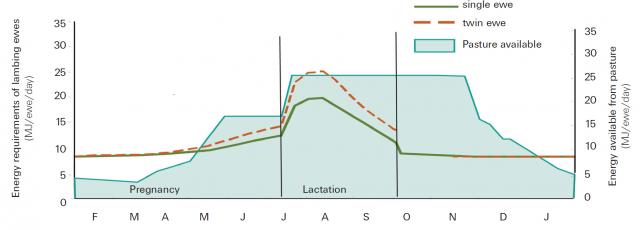The ewe flock is the key flock on the farm so it is important to set up a system that matches their needs with the feedbase.
A ewe’s condition will vary over the season depending on the feed available and her needs. A ewe’s energy needs will double in late pregnancy and triple in lactation. Having enough feed to meet her changing needs is important for production and profit.
Ewe management decisions should be based on the impact of ewe nutrition on her production versus cost. Consider the benefits of providing that nutrition including changes to stocking rate, and wool and sheep trading profit.
Time of lambing for your pasture system
Ewe condition leading up to lambing is more important than ewe condition at joining due to the huge impacts of poor nutrition on the ewe and unborn lamb. However, how the ewe gains that condition prior to lambing can affect the profitability of the sheep enterprise. Supplementary feeding to increase condition (rather than maintain it) is expensive and inefficient, therefore it is important to match best pasture and paddock feed to late pregnancy.
Choosing a time of lambing for your feedbase can be influenced by:
- the ewes’ natural breeding season
- the pasture supply throughout the year and matching it to peak energy demand of ewes
- date of lamb turnoff for slaughter and weight targets
- other critical farm activities.
Choosing a time that matches the ewes’ natural breeding season
Ewes have a natural breeding season with some breeds being less affected by day length than others. Sheep fertility increases as daylight decreases, that is, after 22 December. Pregnancy rates from joining in January and February can be up to 20% better compared to a joining in October and November from ewes of equal condition.
Out of season cycling can be enhanced by the use of teasers and the ‘ram effect’.The 'ram effect' is when non-cycling (anestrus) ewes are stimulated to ovulate by the sudden introduction of a fertile ram or 'teaser' ram.
Matching pasture feed supply to ewe energy demand
The reproductive rate (both conception and the number of foetuses) of ewes is mainly affected by nutrition. As paddock feed supply increases, it can also be beneficial to provide extra feed at certain times in the ewes’ reproductive cycle. For example:
- Pre-joining nutrition affects ovulation rate.
- Mid-late pregnancy nutrition impacts on survival and future performance of the offspring (for example, avoiding pregnancy toxaemia or lifetime effects on wool growth or quality, body composition or reproductive performance).
- Early lactation nutrition affects milk production and therefore lamb growth rates and duration to reach market weight.
- Nutrition around the time of minimum fibre diameter impacts on wool staple strength.
In many enterprises where condition scores peak in early December, ewes are in better condition for joining in November and December. Consequently these enterprises have higher conception and fertility rates than those with ewes mated in the natural breeding season, when in many regions the feed availability is declining rapidly.
In a Merino breeding enterprise, aim to lamb about three to four months before the end of the growing season. This allows ewes to make use of emerging green feed in late pregnancy, and ensures weaners are at a reasonable weight and age before feed quality declines over the summer period.
In a lamb production enterprise, you must decide on the most profitable compromise between number of ewes joined per hectare, nutrition or pasture availability at time of lambing, lamb sale weight and market price at the time of turn-off.


